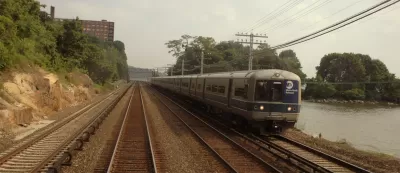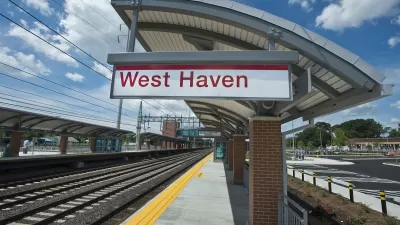The agency is selling land outside of the city on a commuter rail line in a move that could become more common as a revenue-generating strategy.

John Surico reports that the Metropolitan Transportation Authority’s Metro-North Railroad has plans to sell a parcel of land in Harrison, New York, in Westchester County. A private developer will build a transit-oriented, mixed-use development that will include apartments, retail space, pedestrian plazas, and parking.
"The New York MTA, the largest transit agency in the U.S., is becoming more familiar with this type of construction. The Hudson Yards project—where the MTA decked over its train yards, and sold the rights to developers for $1 billion to build an entire Manhattan neighborhood on top, with a new subway line extension beneath—is perhaps the largest TOD project in American history," writes Surico.
Still, he notes that the Harrison development differs from projects in the past because the MTA is looking for revenue sources to help fill major budget gaps. "So the agency is eyeing projects in suburban communities outside of Manhattan, with the hopes that the prospect of economic development will prod smaller towns to plot their futures near its train stations."
FULL STORY: When a Transit Agency Becomes a Suburban Developer

Planetizen Federal Action Tracker
A weekly monitor of how Trump’s orders and actions are impacting planners and planning in America.

DARTSpace Platform Streamlines Dallas TOD Application Process
The Dallas transit agency hopes a shorter permitting timeline will boost transit-oriented development around rail stations.

Four Reasons Urban Planners Can’t Ignore AI
It’s no longer a question of whether AI will shape planning, but how. That how is up to us.

Amtrak’s Borealis Exceeds First Year Ridership Expectations
205,800 passengers have boarded the St. Paul to Chicago line, well above initial MDOT projections.

Study: 4% of Truckers Lack a Valid Commercial License
Over 56% of inspected trucks had other violations.

Chicago Judge Orders Thousands of Accessible Ped Signals
Only 3% of the city's crossing signals are currently accessible to blind pedestrians.
Urban Design for Planners 1: Software Tools
This six-course series explores essential urban design concepts using open source software and equips planners with the tools they need to participate fully in the urban design process.
Planning for Universal Design
Learn the tools for implementing Universal Design in planning regulations.
City of Mt Shasta
City of Camden Redevelopment Agency
City of Astoria
Transportation Research & Education Center (TREC) at Portland State University
US High Speed Rail Association
City of Camden Redevelopment Agency
Municipality of Princeton (NJ)





























